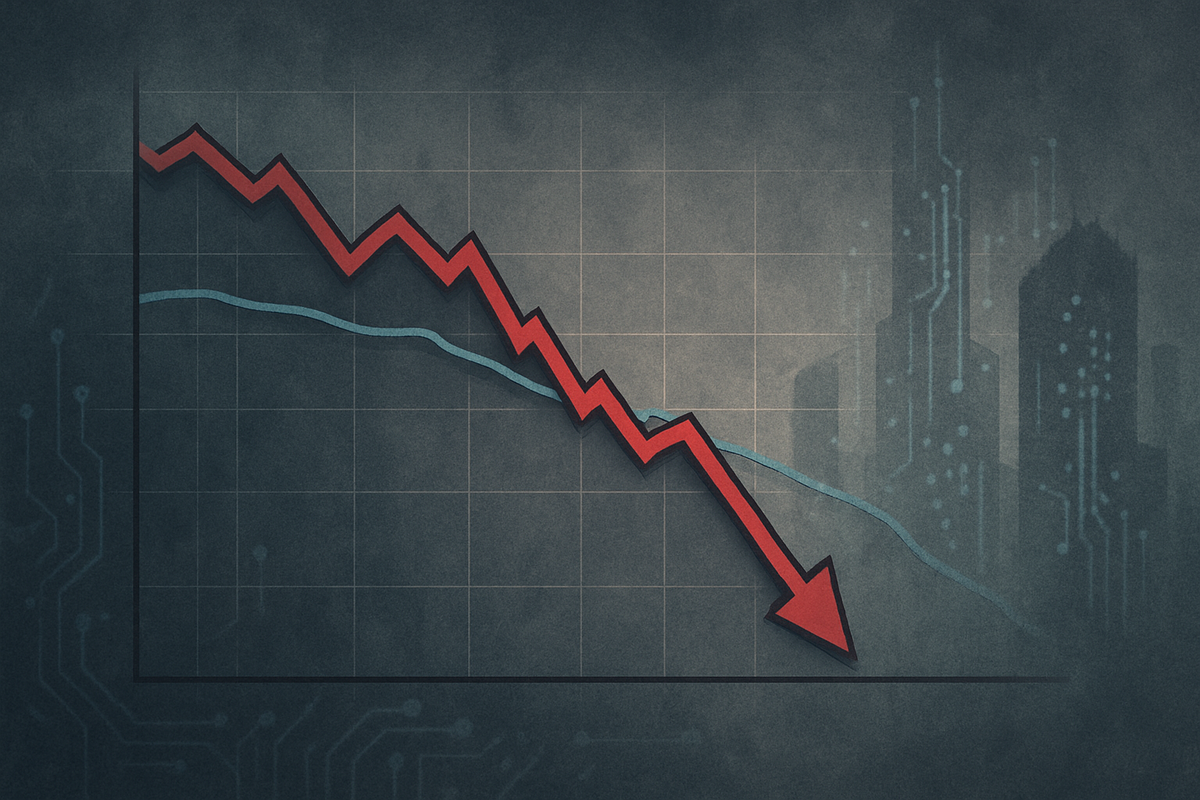
The S&P 500 index has recently fallen below its crucial 50-day moving average, a technical event that is sending ripples of concern throughout global financial markets. This breach, occurring as of November 7, 2025, is widely interpreted by analysts and investors as a significant bearish signal, indicating a potential shift in market momentum and an elevated risk of further declines. The immediate implications point towards increased market weakness, a likely acceleration of selling pressure, and a palpable deterioration in investor sentiment, shifting from cautious optimism to a more overtly bearish outlook.
This technical breakdown is not merely a statistical anomaly but a critical indicator that has historically preceded periods of heightened volatility and deeper market corrections. With short-term control seemingly shifting from buyers to sellers, market participants, particularly institutional investors and systematic trading funds, are recalibrating their strategies. The event underscores a growing apprehension about underlying market health, potentially triggering mechanical portfolio adjustments and prompting a re-evaluation of risk across various asset classes.
The Technical Breakdown: A Closer Look at the S&P 500's Descent
The recent breach of the S&P 500's 50-day moving average is not an isolated event but the culmination of a multi-day weakening trend. On November 6, 2025, the index closed below not only its 50-day moving average but also its 5-, 10-, 15-, and 20-day moving averages, signaling a comprehensive short-term trend reversal. This "flashing signal" for short-term trend followers was followed by the 50-day MA standing at 6,665.75 on November 7, 2025, a critical level that the index has now definitively moved beneath. This technical breakdown has triggered concerns that the index could swiftly move towards the 6,500 level if it fails to find immediate stabilization.
A significant factor contributing to this vulnerability is the deteriorating market breadth. On November 6, 2025, a mere 37.6% of S&P 500 stocks were trading above their 50-day moving average, a notable decline from 41.7% previously. This narrow market participation suggests that recent market gains have been heavily concentrated in a few large-cap companies, particularly within the artificial intelligence (AI) sector, masking broader underlying weakness. Such a condition makes the overall index highly susceptible to downturns when these leading stocks falter.
Key momentum indicators further corroborate the bearish shift. The Relative Strength Index (RSI) is breaking lower, and the Moving Average Convergence Divergence (MACD) has turned bearish, reinforcing the narrative of weakening upward momentum and increasing selling pressure. This three-day downtrend, characterized by strong selling across multiple time frames, indicates a consistent and pervasive shift in market dynamics. Institutional investors and systematic trading funds, which often rely on such technical thresholds, are now adjusting their positions, potentially accelerating the selling pressure as mechanical systems trigger further divestments.
The initial market reaction has been one of heightened caution, transitioning rapidly into a more bearish outlook. Despite the S&P 500 having approached recent highs in early November, underlying fear was already present, as evidenced by indicators like the Fear and Greed Index showing "Fear" and increased purchases of put options. The breach of the 50-day MA is now intensifying this apprehension, leading to accelerated profit-taking and an increase in short-selling activities, as market participants brace for further declines.
Navigating the Volatility: Potential Winners and Losers in a Weakening Market
The S&P 500's breach of its 50-day moving average, coupled with deteriorating market breadth and an unprecedented concentration in the AI sector, sets the stage for a significant reallocation of capital and a clear divergence between potential winners and losers in the corporate landscape. Highly valued growth-oriented companies, particularly those within the technology and consumer discretionary sectors, are poised for significant downside risk, while defensive sectors and companies with stable fundamentals may offer refuge.
Companies at the forefront of the recent AI boom, including mega-cap technology giants often dubbed the "Magnificent Seven" – such as Nvidia (NASDAQ: NVDA), Apple (NASDAQ: AAPL), Microsoft (NASDAQ: MSFT), Amazon (NASDAQ: AMZN), Alphabet (NASDAQ: GOOGL), and Palantir (NYSE: PLTR) – are particularly vulnerable. Their extreme valuations, with Nvidia (NASDAQ: NVDA) reaching a staggering $5 trillion valuation and representing approximately 8% of the S&P 500, mirror the concentration seen during the dot-com bubble. Unprofitable technology firms may face substantial stock price depreciation if the broader market correction accelerates. Recent negative reactions to earnings from companies like CarMax (NYSE: KMX), DoorDash (NASDAQ: DASH), Paycom (NYSE: PAYC), MercadoLibre (NASDAQ: MELI), and Advanced Micro Devices (NASDAQ: AMD) in early November 2025 serve as a stark warning of this heightened sensitivity.
Conversely, defensive sectors are likely to demonstrate resilience, attracting investors seeking stability amidst the turmoil. Consumer Staples companies like Procter & Gamble (NYSE: PG), Coca-Cola (NYSE: KO), Walmart (NYSE: WMT), Johnson & Johnson (NYSE: JNJ), and Costco (NASDAQ: COST) are expected to fare better due to consistent demand for essential goods, regardless of economic conditions. Similarly, Utilities providers, with their stable revenue streams and attractive dividend yields, and Healthcare companies, which benefit from inelastic demand for their services and products, are poised to act as safe havens. Moderna (NASDAQ: MRNA), for instance, has shown modest gains even in recent volatile periods.
Furthermore, large-cap dividend stocks and companies in the energy sector may present opportunities. Companies with strong dividend yields can provide an income cushion, becoming increasingly attractive as other asset classes decline. The Energy sector, characterized by reasonable valuations, managed financial risk through debt reduction, and a commitment to returning capital to shareholders, could also offer a degree of stability. Ultimately, companies that can demonstrate expanding profit margins, irrespective of their sector, will be better positioned to weather the impending market volatility.
Broader Implications: An Overextended Market's Reckoning
The S&P 500's breach of its 50-day moving average on or around November 7, 2025, transcends a mere technical blip; it signifies a critical juncture for the broader financial landscape, reflecting deep-seated trends and potential systemic vulnerabilities. This event fits into a narrative of an overextended market, heavily reliant on a narrow cohort of mega-cap technology stocks, particularly those riding the fervent Artificial Intelligence (AI) boom. The market's current concentration, with the top 10 S&P 500 companies accounting for approximately 42% of its total market value, surpasses even the peak observed during the infamous dot-com bubble of 2000, where the figure stood at 29%. This extreme concentration, exemplified by Nvidia (NASDAQ: NVDA) alone representing about 7.3% of the index and reaching a $5 trillion valuation, makes the entire market susceptible to sharp corrections if these leading stocks falter.
The ripple effects of such a technical breakdown could be far-reaching. Systematic selling, triggered by trend-following strategies of large institutional investors, could cascade across global markets, amplifying volatility. A significant stock market decline often erodes consumer confidence, leading to reduced consumer spending which, in turn, negatively impacts businesses across various sectors. Furthermore, warnings from companies like Qualcomm (NASDAQ: QCOM) regarding reduced order volumes highlight the inherent risks within the semiconductor industry and the broader reliance on a few strategic partners. The Cboe Volatility Index (VIX) already hovering around 17-19 signals elevated market apprehension, and a weakening U.S. Dollar, as some analyses suggest, could further destabilize global trade and capital flows.
Regulatory and policy implications also loom large over this uncertain market. The Federal Reserve's recent hawkish stance, hinting that a December interest rate cut is "far from it," is perceived by some as a potential catalyst for unwinding speculative positions, particularly in AI stocks. Concurrently, an ongoing Supreme Court hearing concerning tariffs imposed during the former Trump administration adds substantial regulatory uncertainty. A decision that redefines executive authority over trade policy could significantly alter expectations for import costs, competitiveness, and global supply chains, potentially leading to a U.S. recession in 2026 if anticipated foreign direct investments (FDI) do not materialize.
Historically, the current market dynamics draw uncomfortable parallels with two major financial crises. The Dot-Com Bubble of the late 1990s and early 2000s saw speculative fervor drive technology stock valuations to unsustainable highs, much like the current AI-driven mania. The S&P 500's exceptionally long streak above its 50-day moving average prior to this breakdown mirrors similar patterns before the dot-com bust, which saw the index drop by nearly 50% in the two years following 2000. Furthermore, the 2008 Financial Crisis serves as a stark reminder of how rapidly market confidence can erode and how deeply indices can fall, with the S&P 500 losing approximately 50% of its value from its October 2007 peak. Noted investor Michael Burry, famous for predicting the 2008 crisis, is reportedly betting against the current AI bubble, underscoring the perceived systemic risk and the historical echoes that resonate in today's market.
The Road Ahead: Navigating Uncertainty and Opportunity
The S&P 500's breach of its 50-day moving average on November 7, 2025, sets the stage for a period of heightened uncertainty, presenting both significant challenges and potential opportunities for investors. In the short term, the market is likely to experience accelerated selling pressure. A decisive close below the 50-day MA, which stood at approximately 6,665.75, could trigger further systematic selling by large hedge funds and asset managers, pushing the index towards initial support levels around 6,641/69, and potentially as low as 6,500 or even 6,400. The "wobbly" appearance of the market's chart, coupled with bearish momentum indicators like the RSI and MACD, suggests that a more significant downtrend could be confirming. Investors should brace for volatile consolidation or even "dead cat bounces" as attempts to "buy the dip" might be quickly overwhelmed by underlying selling pressure, particularly from mega-cap tech names. Furthermore, delayed economic data due to a U.S. government shutdown means reliance on private reports, with recent alarming job cut figures fueling recession fears and potentially pressing the Federal Reserve for more rate cuts.
Looking further out, the long-term possibilities diverge sharply. A more optimistic view posits that this pullback is a healthy correction, necessary to reset overheated technical conditions and valuations, thereby paving the way for continued gains into 2026, with some analysts maintaining year-end S&P 500 targets ranging from 7,000-7,200 by Q1 2026. Conversely, a pessimistic outlook warns of a "bubble burst" akin to the dot-com era, given the S&P 500's Shiller P/E ratio exceeding 40. This scenario could lead to a substantial drawdown as valuation multiples contract. Economic indicators, such as a consistently low ISM Manufacturing Index and negative readings in the Chicago Fed National Activity Index, suggest a potential economic slowdown that could lead to significant downward revisions in corporate earnings estimates for 2025, potentially from nearly 20% to around 7%.
Strategic pivots will be crucial for investors. De-risking portfolios, increasing cash allocations, and reducing exposure to highly speculative or overvalued assets, especially in rapidly gained sectors like AI-driven technology, are prudent measures. Sector rotation towards more defensive segments like consumer staples, utilities, and healthcare, or undervalued opportunities such as real estate, is likely. Traders might employ hedging strategies or utilize inverse ETFs to capitalize on potential downside movements, while long-term investors may cautiously view pullbacks as incremental buying opportunities for high-quality stocks. Monitoring the Federal Reserve's policy will be paramount, as its less dovish stance, suggesting a December rate cut is "far from a foregone conclusion," could significantly impact market sentiment.
Market opportunities, despite the challenges, still exist. Historically, November is the second-highest performing month for the S&P 500, potentially offering a seasonal tailwind. The "Magnificent Seven" tech stocks and the broader AI spending narrative, while concerning for valuations, remain significant drivers for U.S. equities. Undervalued sectors like real estate could benefit from potential future interest rate cuts. However, significant challenges persist, including high valuations, "AI bubble" fears, weakening market breadth, and economic headwinds such as spiking job cuts and ongoing geopolitical risks. The market's "negative gamma regime" further exacerbates selling pressure. The ultimate outcome will likely be one of three scenarios: a shallow correction followed by recovery, a deeper correction leading to a bear market, or an extended period of choppy, sideways trading as conflicting signals create prolonged investor indecision.
The Verdict: A Critical Juncture for the S&P 500
The S&P 500's recent dip below its 50-day moving average on November 7, 2025, marks a critical juncture for the market, signaling a shift from a prolonged period of strength to one of heightened vulnerability and potential downside. The key takeaway is a confirmed technical breakdown, characterized by weakening momentum indicators, a highly concentrated market driven by an "AI bubble," and increasing systematic selling pressure. This confluence of factors, coupled with emerging economic headwinds like rising job cuts and unresolved fiscal uncertainties, paints a picture of a market at a crossroads.
Moving forward, the market faces a significant test of its resilience. While some analysts anticipate a year-end rally if macroeconomic uncertainties resolve, the potential for further downside remains considerable. A sustained break below the 50-day MA could see the S&P 500 test the 6,500 area, with the 200-day moving average around 6,000 serving as a more substantial support in the event of a deeper correction. The market's current "negative gamma regime" could exacerbate price swings, and volatility, as reflected by the rising VIX, is expected to remain elevated. This period is not merely a transient fluctuation but potentially a necessary correction to "right-size" overstretched valuations and temper speculative excesses, ultimately contributing to the long-term health of the market.
The lasting impact of this event could be a fundamental re-evaluation of risk, particularly concerning highly valued growth stocks. It threatens a potential reversal of the prevailing uptrend, possibly marking the beginning of a "bubble burst" if current Shiller P/E ratios, exceeding 40, contract significantly. For investors, the coming months demand vigilance and strategic adaptation. Watch closely for whether the S&P 500 can quickly reclaim its 50-day moving average, or if the breakdown leads to further declines, with key support levels at 6,500 and 6,665 being crucial. Monitor the depth and duration of any correction, the resolution of the U.S. government shutdown, and the Federal Reserve's future policy signals regarding interest rate cuts. Upcoming earnings reports, especially from major technology companies, and continued scrutiny over market breadth and volume trends will provide further clues to the market's direction.
This content is intended for informational purposes only and is not financial advice





